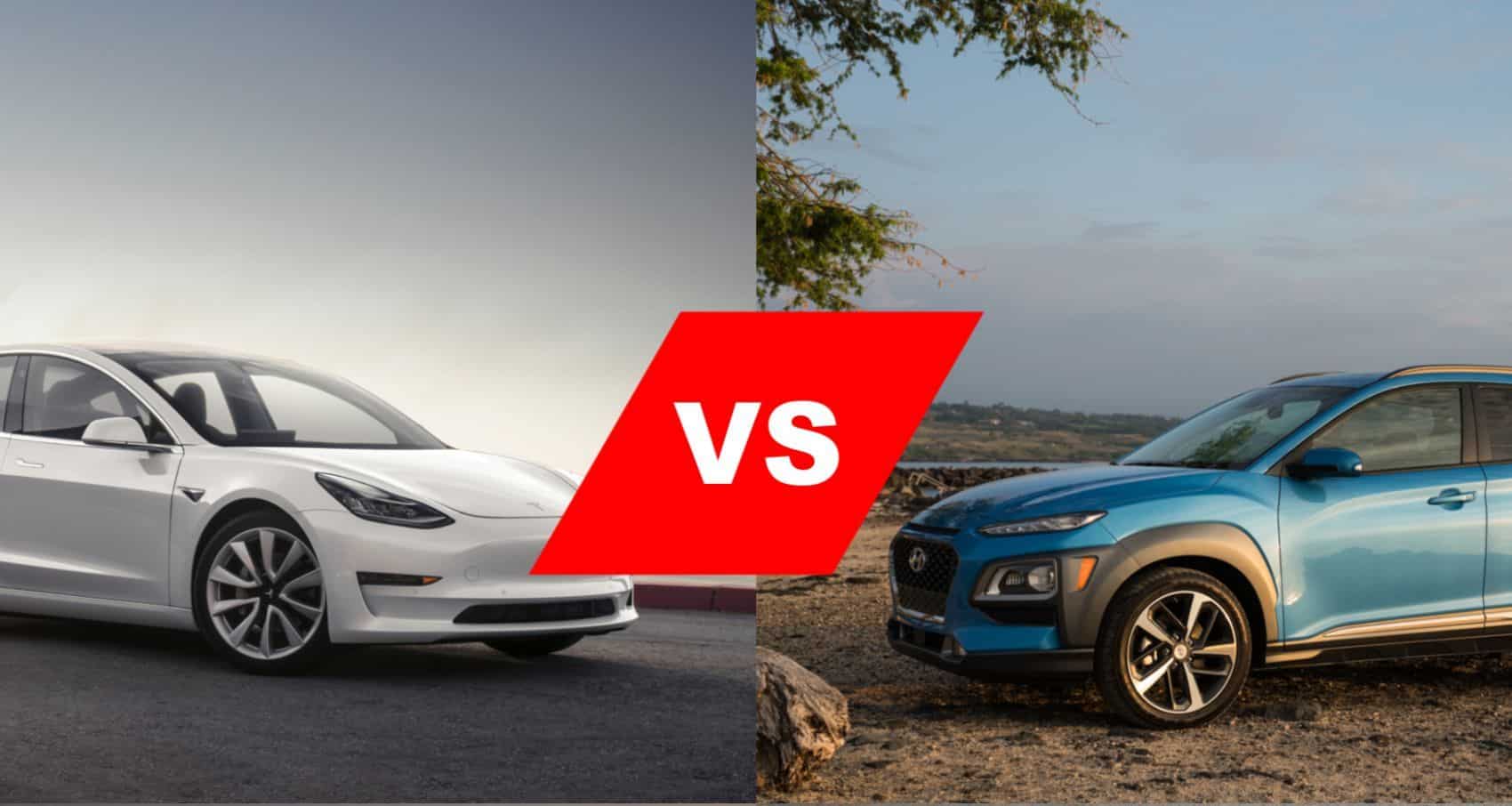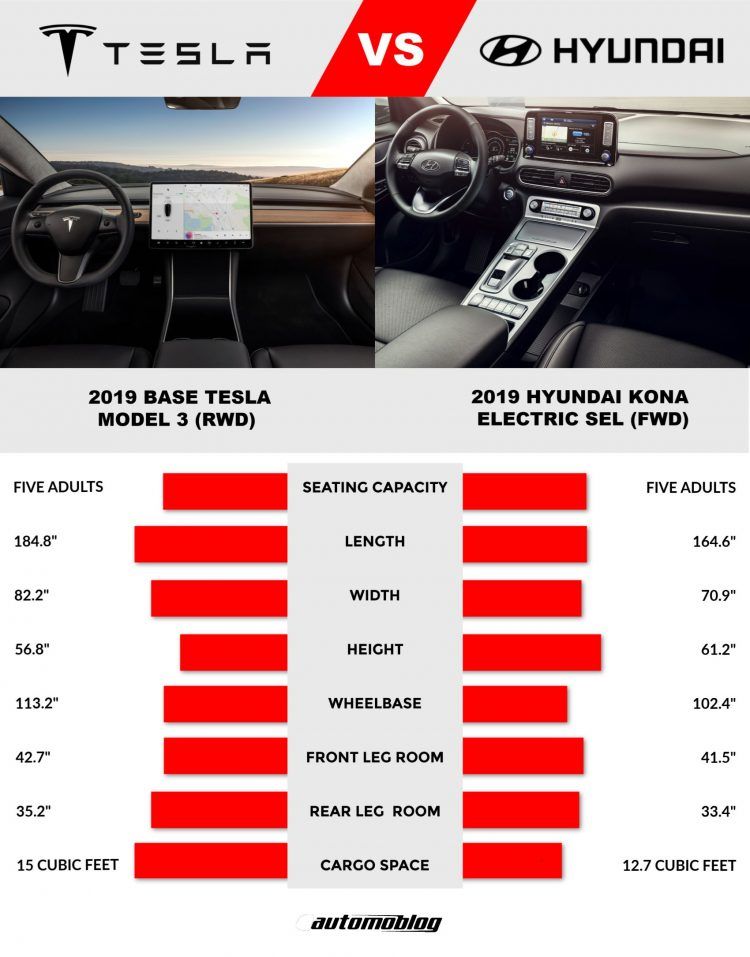- The Tesla Model 3 and Hyundai Kona Electric are two radically different animals.
- However, both are trying to knock down the barriers associated with EV ownership.
- And both are affordable; both offer a lot for the money. And both are viable options.
- Tesla’s Model 3 and Hyundai’s Kona Electric go head-to-head in this virtual showdown.
First off, a bit of clarification. Why in the world are we comparing the Tesla Model 3 with the Hyundai Kona Electric? The Tesla Model 3 is a sporty sedan that sits low to the ground, while the electrified version of the Hyundai Kona is a small crossover.
No, my eyes are fine, thank you. But if you think about it, how long did buyers have to wait for the affordable base version of the Model 3?
But now that it’s here, it’s only fitting to compare it with the Hyundai Kona Electric.
And yes, Hyundai managed to beat Tesla in the race to come up with an affordable EV, but not by much. Although, before Tesla had the guts to introduce a base Model 3, Hyundai created what could possibly be the best mass-market EV. With prices starting at $36,450 (before tax credits), it’s a relatively affordable roundabout as well.
Setting The Stage
The Tesla Model 3 is currently sold in three flavors. The base Standard Range Plus starts at $39,500 (before tax credits) and offers 240 miles of range. The Long Range trim is good for 310 miles and starts at $49,500 (before tax credits). The Performance trim has the same 310 miles of range (but a quicker zero to 60 time) and starts at $59,500. These prices do not include destination and other charges. Tesla has a tendency to change the prices on their vehicles, and it happens abruptly. It happened before, and it will happen again.
You can pay more or less depending on where you live too, so keep this in mind as we proceed.
For this virtual showdown, we are pitting the base Tesla Model 3 Standard Range Plus against the base Hyundai Kona Electric. Interestingly enough, the Kona EV is available in three trim levels (SEL, Limited, and Ultimate) but all are equipped with the same battery pack and electric motor. The Hyundai Kona Electric SEL has a starting price of $36,450 (before tax credits and destination charges).
Tesla Model 3: The Gold Standard
Production and quality issues aside, the Tesla Model 3 remains the gold standard for a relatively affordable EV. In fact, it is considered by many as the new age luxury car. With prices hovering below $40,000, it is seriously pulling on the heartstrings of the masses. It seems buyers are prepared to pay any figure (and deal with long wait times) in order to experience a Tesla, and I get that. However, if you can’t swallow spending more money to abandon a traditional gasoline-fed car, you’re not alone.
Tesla may be late, but the base Model 3 arrived with a vengeance. Making matters more interesting are the significant price cuts to the Model S and Model X. Some say Tesla is desperately seeking attention to sway the odds in their favor. In my mind, the company is fulfilling the final stages of the ultimate goal: to deliver a gorgeous, hi-tech, long-range, fun-to-drive electric car at the lowest price point.
Tesla is not without its fair share of detractors. And believe me, they are aplenty! When faced with such opposition, I repeatedly tell them the same thing: Tesla started the real EV revolution, and they deserve kudos for that.
Blistering Performance
For some people, paying upwards of thirty grand is still a lot for a new car. But for those who know, the price is nothing compared to the fuel savings and performance of the base Model 3. True to Elon Musk’s credo of creating an EV that’s fun to drive, even the base Tesla Model 3 will oblige the wishes of the heaviest right foot.
The base Tesla Model 3 (Standard Range Plus) uses a single electric motor and single-speed automatic to turn the rear wheels. It can rush from zero to 60 mph in 5.3 seconds. The estimated range is 240 miles or 386 kilometers. Prices start at $39,500 but you’ll end up paying around $35,750 after tax credits are applied.
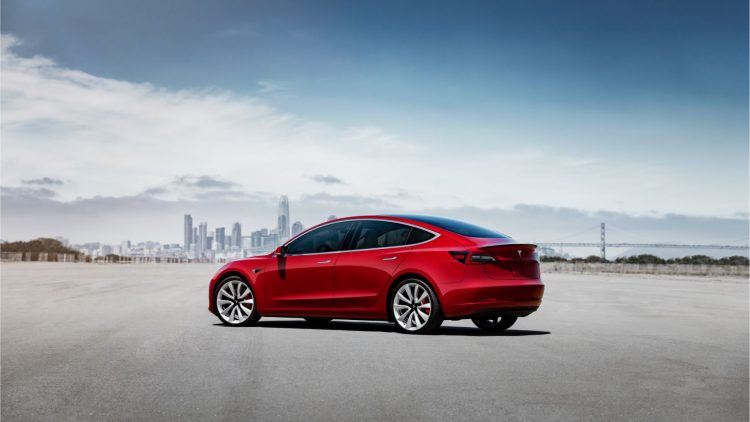
Minimalist Yet Modern Interior
What’s not to love about the Tesla Model 3’s minimalist interior? The dashboard is devoid of conventional buttons and switches. All you get is a 15-inch center touchscreen to control various vehicle settings and that’s it. It is obnoxiously hi-tech yet incredibly easy to use.
The glass roof bathes the interior in natural light. Yes, the base Tesla Model 3 comes with a tinted glass roof. There are two scroll buttons on the steering wheel that perform different functions depending on the chosen setting. The Model 3 has no conventional air vents, which further cleans up and unifies the design of the dash. The interior feels incredibly different and yet familiar at the same time. The Tesla Model 3 is no harder to use than a basic smartphone.
Exciting as it may sound, the arrival of the base Tesla Model 3 is not without compromise. The interior is a bit low-rent with cloth seats and manual adjustments. Not a big deal unless you’re that sophisticated, but the all-black interior is not to everyone’s liking. What I do like are those standard 18-inch aero wheels, however.

Superior Practicality
The Tesla Model 3 offers the interior volume of a mid-size luxury sedan. It can seat five people and offers 15 cubic-feet of cargo space in the rear, with more space under the front trunk or “frunk.” If you need to carry longer items, simply fold the rear seats down for more room. Tesla managed to tick all the right boxes in turning the Model 3 into an everyday commuter.
With the Standard Range Model 3, you still get an impressive amount of kit. This includes maps and navigation, Bluetooth, and a basic audio system. Also standard is lane departure warning, forward collision warning, blind-spot monitoring, and collision avoidance. Enhanced autopilot is also available and includes adaptive cruise control, self-parking, lane keeping assist, and automatic lane changing.
Tesla Model 3 Charging Options
The Tesla Model 3 comes standard with a 32-amp on-board charger. Long-range models receive a 40-amp charger. Also included is a 20-foot mobile connector and plug along with a 120-volt NEMA 5-15 adapter; NEMA 5-15 meaning your common, everyday household outlet. Charging in this way provides roughly three to five miles of range for every hour of charging, although Tesla has a variety of other adapters that warrant more miles per hour of charge time.
But what makes the Tesla Model 3 superior than other EVs is the fast-charging or supercharging capacity. The Model 3 has a DC fast-charging rate of 170 miles of range in 30 minutes. This means you can get back on the road faster than other electric vehicles. The system is also designed to erase range anxiety, which is one of the biggest concerns in purchasing an EV.
Hyundai Kona Electric: The Evolution of Affordable EVs
It’s true. The Hyundai Kona Electric is not only a more gorgeous rendition of the Kona crossover, it’s the evolution of an affordable EV. Prior to the arrival of the base Tesla Model 3, the Hyundai Kona Electric was already on the list of the best and most affordable electric vehicles. Not because it’s a crossover or small SUV (which are desirable in today’s market), but the Kona Electric makes a compelling case to ditch owning a gasoline car in the first place.
I have to admit, the Hyundai Kona Electric is not as fast or as cool as the Tesla Model 3. But at this stage in the EV game, being fast or cool is only a novelty. In order for a mass-market electric vehicle to succeed, it needs to have three main things: long range, easy charging, and an affordable price. All other things (like speed and the “cool factor”) are just a bonus.
With that being said, the Hyundai Kona Electric seems to be hitting the right spots.
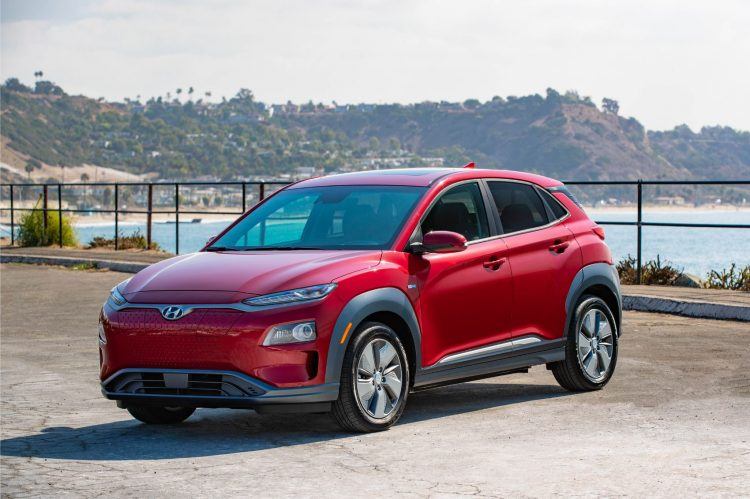
Superb Performance
The Hyundai Kona Electric is motivated by a single, permanent magnet synchronous AC motor rated at 201 horsepower and 290 lb-ft. of torque. This is enough to propel the Kona Electric from zero to 60 mph in 7.6 seconds, slower than the base Tesla Model 3. That’s not too bad if you think about it, since the Hyundai Kona Electric is a crossover rather than a sedan. However, speed is only a small part of the equation.
What really makes the Hyundai Kona shine is the 64 kWh lithium-ion battery pack, good for an EPA-estimated range of 258 miles. It tops the Jaguar I-Pace (234 miles) and the Chevrolet Bolt EV (238 miles), and more importantly, it outlasts the base Tesla Model 3!
In this regard, the Tesla Model 3 is clearly outclassed by the Hyundai. This is how the Kona Electric is breaking the barriers to EV ownership. It offers a longer range than comparably-priced alternatives, and is realistically more affordable in the real world.
Sporty Driving Feel
Despite having a less powerful electric motor than the Tesla Model 3, the Hyundai Kona Electric makes use of clever engineering to deliver a sporty feel. The battery pack sits low in the floor. It shifts the center of gravity 3.6 inches lower to the ground than a conventional, gasoline-powered Kona. This gives the Kona Electric the handling characteristics of a car, most especially in Sport mode.
The Hyundai Kona Electric is also equipped with regenerative braking. There are paddles behind the steering wheel that adjust the regen settings. This feature allows for true one-pedal driving, which is more fun than it actually sounds.
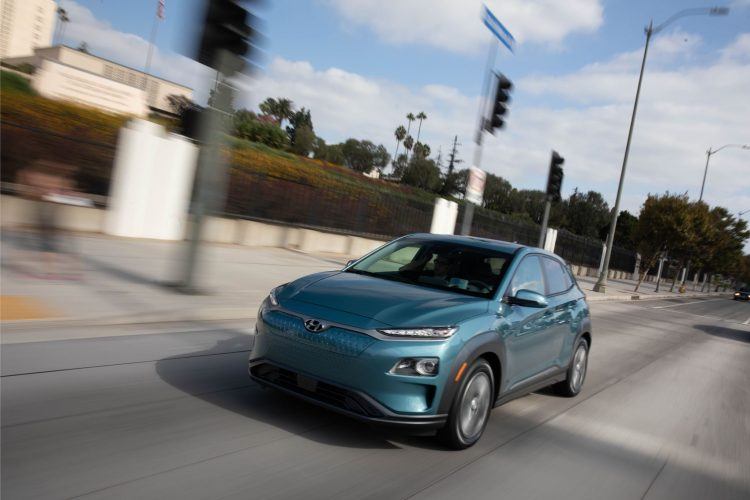
Practical Interior
The Hyundai Kona Electric is a five-seat crossover. However, since it is based on the gasoline version of the Kona, you can expect a cramped back seat with less cargo room than the Tesla Model 3. But since the Kona Electric is only 164.6 inches long, this is not exactly a deal breaker.
And while the interior of the Kona Electric is still home to an array of buttons and switches, it doesn’t look or feel as hi-tech as the minimalistic dashboard in the Tesla Model 3. Then again, this is not a bad thing. If you want to familiarize yourself with the controls in the Hyundai Kona Electric, you can do so without getting lost in a sea of menus and sub-menus.
In truth, the interior of the Hyundai Kona Electric is no different from the gasoline model, save for the omission of a conventional shift lever. It is now replaced with buttons to engage Park, Neutral, Reverse, and Drive.
The Hyundai Kona Electric SEL comes with LED daytime running lights, a seven-inch touchscreen display and seven-inch gauge cluster; LED taillights, heated front seats, automatic climate control, a leather-wrapped steering wheel, Apple CarPlay and Android Auto, and 17-inch alloy wheels. Not bad for a base price of $36,450 (before tax credits), right?

Hyundai Kona Electric Charging Options
The Hyundai Kona Electric is equipped with a 7.2 kW AC on-board charger. It juices up the 64 kWh battery pack in approximately 10.5 hours with a 240-volt outlet. The vehicle also supports DC fast-charging using Hyundai’s SAE Combo Charging System (CCS). It can fast-charge the battery pack in just 45 minutes. However, the fast-charging CCS system is not as common as Tesla’s supercharging network. This gives the Hyundai Kona Electric a disadvantage in long-distance and cross-country driving.
Tesla Model 3 Versus Hyundai Kona Electric: The Verdict
This is a tough one. While I’m all high praises for the styling, performance, and driving feel of the Tesla Model 3, it’s hard to ignore the value proposition of the Hyundai Kona Electric. I believe Tesla is in a conundrum. It feels like the company is shooting itself in the foot with the base 240-mile Model 3. In order for it to be great, it needs to have more than just a lower price. It needs to have an upgraded battery pack to match or surpass the range of the Hyundai Kona Electric, and other similar EVs already on the market.
Sadly, that’s not the case. Good move, Hyundai. We don’t have official figures yet on the base Model 3’s battery capacity, but Hyundai managed to up the stakes even before the base Model 3 came to fruition. If you want a Tesla Model 3 with at least 300 miles of range, you’ll need to choose the long-range model, which starts at $49,500 (before tax credits). Your range will increase and your zero to 60 time will be faster, but that dollar figure is not exactly classified as affordable.
I’m not hiding the fact the Tesla Model 3 is the superior vehicle in this comparison, but make no mistake about the Hyundai Kona Electric. It remains a brilliant choice if you need a longer-range electric crossover.
Alvin Reyes is the Associate Editor of Automoblog. He studied civil aviation, aeronautics, and accountancy in his younger years and is still very much smitten to his former Lancer GSR and Galant SS. He also likes fried chicken, music, and herbal medicine.
Photos & Source: Tesla Motors, Hyundai Motor America.


